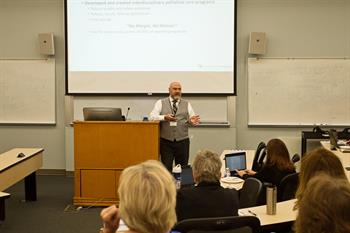Palliative care eases suffering in patients battling serious diseases, a population on the rise as Americans age and medical treatments advance. Yet despite the increased need, palliative care programs are dwindling — and it all circles back to money.
That was the message of Sean Reed, PhD, APN, ACNS-BC, ACHPN, who has made closing that gap a personal mission. Reed, an assistant professor in the University of Colorado College of Nursing, shared his research focused on creating alternative reimbursement models for palliative care during the Oct. 14 Grand Rounds.
Reed worked with Erin Austin, PhD, assistant professor of mathematical and statistical sciences at the University of Colorado Denver, on his most recent project.
Fee-for-service models failing palliative care
“Unsubsidized palliative care programs are shrinking, closing or are unable to expand despite increased population needs,” Reed said, citing the saying no margin, no mission.
And, when it comes to palliative care programs, common fee-for-service reimbursement models frequently fail that test, Reed said.
Quality palliative care programs are costly, and fee-for-service models cover only 20% to 60% of operating expenses, he said. Moreover, disciplines that cannot bill directly as providers (social workers, chaplains, RNs) receive no reimbursement in a traditional multi-disciplinary palliative care model, Reed said.
Palliative care supports patients at any disease stage
 Often confused with hospice care, palliative care programs provide support for patients and caregivers at any age or stage of a disease, and patients may undergo curative treatment concurrently.
Often confused with hospice care, palliative care programs provide support for patients and caregivers at any age or stage of a disease, and patients may undergo curative treatment concurrently.
Many studies have found that palliative care programs alleviate patient pain and stressors and improve caregiver quality of life, Reed said. The programs are crucial in today’s fragmented healthcare system, which fails serving the chronically ill well, Reed said.
Fee-for-service programs have no link to quality or value. “In the traditional fee-for-service model, a provider who does a bad job gets reimbursed the same as someone who does a good job,” Reed said.
Fortunately, a movement has begun in the industry away from fee-for-service toward new alternative reimbursement models that link quality and cost, Reed said. “Providers should be focused on delivering high-quality palliative care, not worrying about these financial numbers.”
Alternative reimbursement models could help save service
Reed introduced a recent alternative model proposed by the American Academy of Hospice and Palliative Medicine called the Patient and Caregiver Support for Serious Illness. The two-tiered per-member per-month model divides moderately complex cases from highly complex cases.
Reed and Austin’s simulation of the model (a project still in progress) found basing reimbursement on patients’ predicted use of services could increase savings and help enhance and expand palliative care programs.
“If we want to provide more palliative care for patients, then we have to change policy,” Reed said. “It’s going to be a few years before we can figure out all the data, but alternative reimbursement models might be an economical solution towards palliative care program sustainability.”


